PSYC341- Final Exam (Units 9-12)
1/93
There's no tags or description
Looks like no tags are added yet.
Name | Mastery | Learn | Test | Matching | Spaced |
|---|
No study sessions yet.
94 Terms
Graphemes
letters
minimal meaningful units in the writing system of a particular language.
It is usually a letter or fixed combination of letters corresponding to a phoneme in that language.
Language is generative. Explain what that means.
Can combine units to create an infinite number of meanings
Phonology
the study of speech sounds in language
What are the sounds?
How can they be combined?
the study of sound systems and abstract sound units
Phonemes
in language, the smallest distinctive sound unit
Ex: p, b, d, and t in the English words pad, pat, bad, and bat.
Semantics
Meaning of words and sentences
Morphology
the structure of words and word formation in a language
the study of words, including the principles by which they are formed, and how they relate to one another within a language.
Syntax
the rules for combining words into grammatically sensible sentences in a given language
the arrangement of words and phrases to create well-formed sentences in a language.

Pragmatics
the practical use of language that includes the ability to adjust language communication according to audience and context
how context contributes to meaning
What makes speech perception complex?
What do we actually get in the speech signal?
Segmentation problem: how to divide up the speech?
"There are no pauses between the words"
Also:
Style
Accent/dialect
Environment
Intonation
Coarticulation of Phonemes
the effect that surrounding phonemes have on the production of any particular phoneme.
A phoneme can be physically different in different contexts: the mouth movements that need to come before and after a particular phoneme slightly change its sound.
You can see this pretty easily in word like "tea" versus "too" - both have the /t/ phoneme, but when anticipating needing to spread the lips for "ee" sound when you are saying /t/ the lips are spread, but in anticipation of rounding the lips to say "oo" the lips are already rounded while saying the /t/ in too.
Do we tend to perceive phonemes in categories or along a continuum?
We tend to perceive phonemes categorically (any two /ba/s will sound like equally good /b/ sounds, even if the physical characteristics differ). Even though you might kind of hear the difference (as described above), you're still perceiving the sound as a /b/. Perceiving the sound as a /b/ means it'll act like a /b/ in any word. For example, it doesn't change the meaning of the word. "bear" with /b/ of voice onset time = 0 ms and 10 ms, you'd point to a picture of a brown furry creature both times, but once you cross the category boundary, it's a different sound category and you'd hear the same word with VOT = 20 + ms and you'd hear pear/point to a picture of a green fruit.
Are phonemes actually produced in categories or along a continuum?
Sounds are actually produced on a continuum - various properties of the sound can take on a variety of values like higher or lower frequencies or shorter or longer voice onset times.
What is the phonemic restoration effect? Give an example of how it would be demonstrated. Explain how it provides evidence of top-down processing.
Using prior knowledge to make inferences.
People hear a sentence and there is a buzz or cough in the middle of the sense, the people used what they learned later in the sentence so say what they heard.
Top-down processing involves perceiving things based on your prior experiences and knowledge.
Ambiguous messages are more difficult to process than unambiguous messages because you need to resolve conflict between two competing interpretations. What can help with picking an interpretation?
To resolve ambiguity people can use context like the physical environment or previous conversation, or they can use the statistics of the language they've learned over a lifetime.
Speech Production
the process by which thoughts are translated into speech.
the process of going from a concept to creating a physical sound wave, including translating the concept into individual lexical items, arranging the lexical items into an order that makes sense based on syntactic rules, translating from the ordered lexical items to phoneme representations, and then from phoneme representations to associated speech-motor movements that push around air to make the sound wave.
Linearization Problem
In language production, the difficulty of arranging words in an ordered, linear sequence.
The linearization problem is a "problem" just meaning that it's something hard to do computationally. Concepts don't have any particular order in time. For example, if you think of how you might store a memory of an event of a soccer match, the representation isn't necessarily unfolding with one element at a time over time. People might be kicking the ball while others are running and fans are cheering in the stands. All this is simultaneously going on in the real life event and in our brain's representation could also be similarly "overlapping in time". But the problem with expressing this in language is that the speech signal is air pressure changes that occur over time, so you can only say one phoneme at a time, like beads on a string (like a line/linear). So there has to be a process to get from one format with lots of overlapping, simultaneous, information, to another format where the information is linear. So that's where all the steps in 4) come in, and that's the process of "linearization".
Discourse
verbal expression or exchange; conversation
Usually we talk in groups of sentences and we talk to people
We have to know how to put the ideas together at a higher level
There's topics/structure within a conversation

Give an example of how we might adjust our speaking style depending on who's listening.
Audience design is changing what we're saying depending on what people know
You need to know what the other person already knows
Aiming low means tailoring your message to the people who know the least
Ex: explaining a psychological concept or diagnosis
Prescriptive perspective when describing language
describes how language "should be", focuses on what's correct
Descriptive perspective when describing language
describes how language is actually used, focuses on what's accepted by the linguistic community
Briefly describe the following properties of language: communicative, arbitrarily symbolic, regularly structured
Communicative → com specific (same species)
Arbitrarily symbolic → arbitrarily (not related), symbolic (relating to symbols): the meaning of linguistic signs is not predictable from its word form, nor is the word form dictated by its meaning/function.
Regularly structured →has an order to it, and if it doesn't have an order it doesn't make sense
Briefly describe the following properties of language: generative, dynamic, socially transmitted, universally acquired
Generative → combine structures in any order to express anything you want to talk about
Dynamic →has to be able to change, agreement among all of the people, new things come to exist
Socially transmitted→ have to have other people around to learn language
Universally acquired→ anyone can learn the communication system
Give an example of animal communication. Does it qualify as language? Why or why not?
Vervet Calls
Specific calls that relate to different predators
It is not generative, they don't have specific calls for other predators
Don't know if it is regularly structured
So it does not qualify as language
Saccade
A type of eye movement, made both voluntarily and involuntarily, in which the eyes rapidly change fixation from one object or location to another.
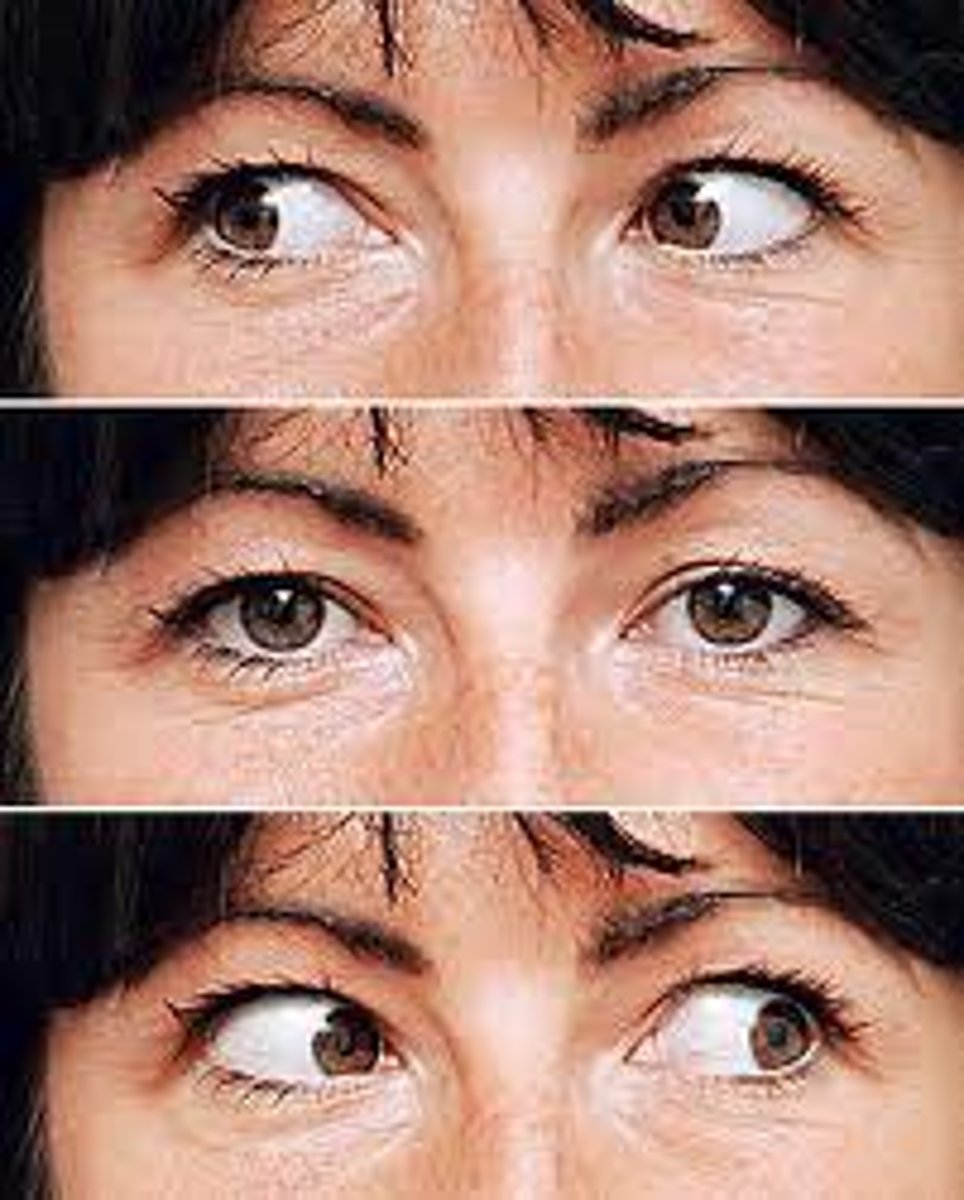
Fixation
Brief pauses during which the eye takes in information
Regressive Saccade
an eye movement backwards to re-read
Occur when a reader makes too long of a saccade and has to backtrack, or if a word is particularly difficult to decipher.
What is a typical perceptual span when reading English? Is it symmetrical or asymmetrical?
Perceptual Span: how much text our eyes can see during a fixation
For English: approximately 3 characters left & 15 characters right of fixation point.
Asymmetrical
When reading, our eyes skip some words. Approximately what percent of words are skipped? What kinds of words are most likely to be skipped?
Approx. ⅓ of words are skipped
Most likely to skip:
Short, unimportant words
High-frequency (common) words
Highly constrained words
Orthography
the conventional spelling system of a language
physical structure of words (written)
Direct Access View
the view that orthography provides the major route to word recognition
Indirect Access View
word recognition requires a phonological representation before its identification
What is some evidence that word meanings can be accessed indirectly (via phonology)?
When people are asked to do verification tasks for reading words like rose -- is it a flower?, reaction times to say yes or no are slower for homophones (ex: rose/rows) than non-homophones like dairy. The idea being that for reading homophones, both meanings (that are connected to the same sound/phonological representation) are activated and when there are competing representations to pick between this slows people down (ex: for one of the phonological to concept representation the answer is yes and for the other phonological to concept representation the answer is no). If reading the word did not activate the phonological representation, since rose and rows are spelled differently, there would be no competition - the written word (orthographic representation) would just be connected to the relevant concept. It would be just as easy as trials like daisy, which doesn't have competing phonological representations.
Morphemes
The smallest units of meaning in a language.
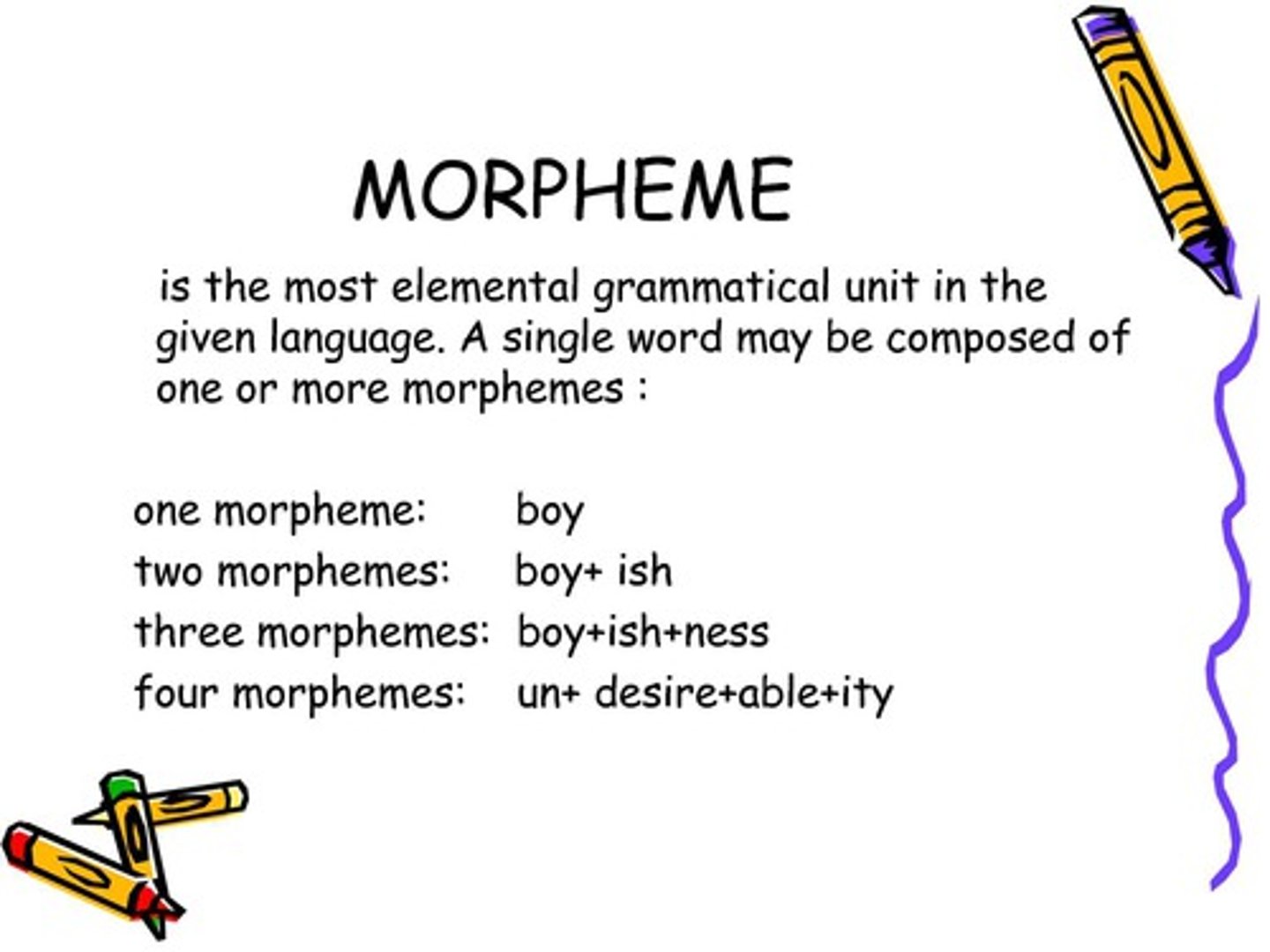
Types of Morphemes
free and bound
smallest units of language that carry meaning.
Ex: tree, walk, -ed, -s, un-
Free morphemes: can stand alone
Bound morphemes: must accompany a free morpheme
Language
Symbolic, rule-based, generative system for communication.
Communication is mental representations/concepts from one person to another.
Language is symbolic. Explain what that means.
Sounds/signs/written symbols stand for something out in the world
Language is rule-based. Explain what that means.
Has structure and the structure is meaningful
How are phonemes and graphemes related?
Phonemes and graphemes are both units of language that make up words - phonemes makeup spoken words and graphemes make up written words.
Graphemes generally are meant to represent phonemes so the written letter B or b stands for the /b/ sound. But the relationships between graphemes and phonemes is more complicated than this for English e.g. digraphs like CH stand for one sound and sometimes multiple sounds correspond to one letter like C stands for /s/ sometimes e.g. circle and /k/ other times e.g. cat. Different languages have different properties of how 1-to-1 their phoneme-grapheme mappings are
Whole-word Approach (to teaching reading)
Learning new words by memorizing the entire word.
Whole-language Approach
An approach to reading instruction based on the idea that instruction should parallel children's natural language learning. Reading materials should be whole and meaningful.
Engaging materials, encouraged to guess, no correcting
Try to use context, try to use pictures
How can they map new words to words they already know
Phonics
a method of teaching people to read and pronounce words by learning the sounds of letters, letter groups, and syllables
Learning correspondence between component letters and their sounds
Able to sound out new words
Connecting graphemes to phonemes
Needs to be a key component in teaching kids to read.
Which method of teaching reading has been demonstrated to be best?
Phonics is best. Versus whole word or context based approaches where the goal is memorizing word shapes or using context cues like pictures. To learn to read (effectively) you need to understand how letters relate to sounds and be able to sound out new words you've never seen before.
Reasoning
the process of drawing a conclusion on the basis of evidence
evaluation of a conclusion based solely on given information
Judgment
using some sort of reasoning to arrive at a conclusion, an inference, an estimate, or a prediction
Using information and reasoning to arrive at some conclusion
Inferring, estimating, predicting
Making an educated guess, based on limited information and our previous knowledge, expectations, and beliefs
Decision Making
using reasoning & judgment to make a choice among several alternatives (involves some risk or uncertainty about what the best choice is)
Choosing between alternatives, under conditions of uncertainty
Normative Approach
how people ought to think in a given situation to be considered "rational"
Descriptive Approach
how people actually do think (which may not be "rational")
Heuristic Mode of Thought
Thinking quickly and without much deliberation (more automatic)
Relying more on previous experiences, beliefs, intuitions
Using mental shortcuts or rules of thumb
Efficient, but imperfect
If you have time restraints heuristic may be better
Analytic Mode of Thought
Thought that is relatively slow, deliberate, & controlled
More cognitively demanding
Tends to take more time
Inductive Reasoning
Moving from specific pieces of data toward a general conclusion or rule
(specific to general)
Deductive Reasoning
Determining if a specific conclusion is valid based on general assertions (i.e., premises)
(general to specific)
Explain the difference between evaluating the validity of the argument (valid vs. invalid, which reflects reasoning) vs. evaluating the truth of the statements.
Validity: the quality of being logically or factually sound; soundness or cogency.
Has statements, does the final statement logically follow or not?
Not evaluating the truth of the statement, but instead if it is logical
Can be valid but not true, can be true but not valid argument.
What are "heuristics"? Why are heuristics useful? Do they sometimes have drawbacks?
Heuristics: Rules of thumb that can help guide our judgments
Often very useful, but can sometimes hinder our judgments
Availability Heuristic
Basing our estimates of likelihood on the ease with which examples come to mind
Based on memory
But watch out for biases!
Biased encoding (e.g., "front page news")
Biased retrieval (e.g., due to familiarity or recency)
Illusory correlations - we notice coincidences and might think events are linked, even when they're not
Representativeness Heuristic
judging the likelihood of things in terms of how well they seem to represent, or match, particular prototypes; may lead us to ignore other relevant information
judging likelihood of group or category membership based on similarity
We assess the degree to which the object represents (is similar to) our basic idea (stereotype) of that object
Conjunction Fallacy
when people think that two events are more likely to occur together than either individual event
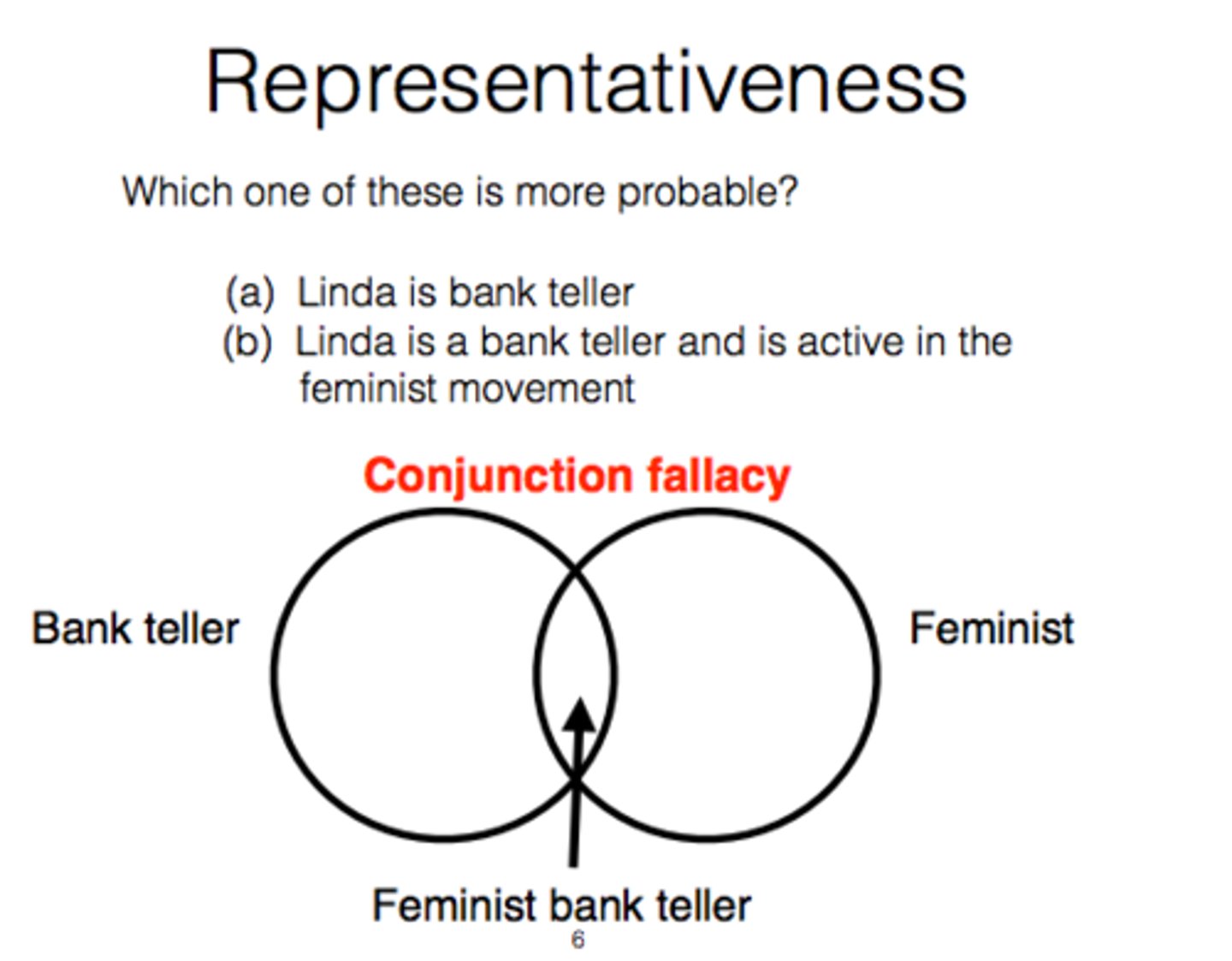
Recognition Heuristic
When faced with two alternatives—one that's recognizable and one that's not—we tend to infer that the recognizable one is bigger/greater/more ___ /etc.
E.g. pairs of cities - Which has the larger population?
San Diego vs San Antonio; Americans vs. Germans
(Lack of info can sometimes be informative!)
German participants were doing better than the American participants on average, the German participants were more able to use the recognition heuristic (what they had heard)
Americans had likely heard of both cities
Anchoring and Adjustment Heuristic
a natural tendency for people to be influenced by an initial anchor point such that they do not sufficiently move away from that point as new information is provided
Making an initial estimate based on some knowledge or presented information, then making adjustments to the initial "anchor"
The initial anchor is powerful
You might not make sufficient adjustments away from it
ex: For example, a used car salesman (or any salesman) can offer a very high price to start negotiations that are arguably well above the fair value

Hindsight Bias
After an event has occurred, the tendency to believe we could've predicted that outcome
Difficult to ignore what you now know
"I-knew-it-all-along effect"
Once you know the outcome of something it's hard to set it aside
Expected Utility Theory: what is it and is it normative or descriptive?
The idea that people are basically rational, so if they have all of the relevant information, they will make a decision that results in the most beneficial result.
a normative approach
decisions based on expected value (benefits and costs) of outcomes and their respective probability
What is a major limitation of Expected Utility Theory?
But people don't always make decisions consistent with Expected Utility (Value) Theory
Decisions may vary, depending on how the options are presented
Prospect Theory: what is it and is it normative or descriptive?
people choose to take on risk when evaluating potential losses and avoid risks when evaluating potential gains
a descriptive approach
tries to explain violations of Expected Utility Theory
decisions affected by amount of gain or loss from what we currently have
gains and losses felt differently (losses felt more)
People are often averse to loss
framing is important
Prospect Theory suggests that framing is important in influencing people's choices. Are people more likely to take risks in a gain frame or in a loss frame?
Framing is important in terms of the risks that you're willing to take
Benefits- certainty
Losses - riskier options
Gain frame → risk avoidant (prefer sure wins)
Loss frame → risk prone (maybe we can avoid the loss)
People are more likely to take risks in a loss frame
Sunk Cost Effect
the willingness to do something because of money or effort already spent
The tendency to continue investing in something (or continue following through with something) even in the face of loss, because of how much time, effort, or money we've already invested
What are the four components of a problem? Briefly explain each.
1. Initial state- state at beginning of problem: Current situation ≠ Desired situation
2. Goal state- desired situation: Solution to the problem
3. Rules and constraints: What you can and cannot do
4. Obstacles: Must be overcome to achieve goal
Well Defined Problem
a problem with a well-stated goal, a clear starting point, and a relatively easy way to tell when a solution has been obtained
Clear and structured
Components are well understood
When it is solved, you'll know it's solved
Ill Defined Problem
A problem lacking clear specification of either the start state, goal state, or the processes for reaching the goal state.
Fuzzy and abstract
Components not well understood
Harder to tell when a solution is reached
Routine Problem
A problem that is familiar and has a known solution
Can be solved by applying well-practiced procedures.
Components of the problem are familiar.
Can recognize initial state; can determine the goal state; knows rules and constraints; knows how to avoid or overcome obstacles
Non-routine Problem
Components are not familiar.
Harder to identify initial state; harder to determine the goal state; rules or constraints are unfamiliar, possibly unknown; tough to avoid or overcome obstacles
First-time problems are non-routine but many can become routine with practice.
What are some challenges faced by researchers who study problem solving?
Many different types of problems (Complex vs. simple; brief vs. time-consuming; real-world problems vs. puzzles/brain teasers; etc.)
Problems can be time-consuming to solve!
How to observe or measure problem-solving?
What processes are involved?
In what ways have verbal reports helped researchers understand problem solving?
Verbal reports let researchers understand the step by step of something that's only internal/might not be obvious from the external behavior of carrying out the steps (e.g. think the same kind of benefit as showing your work in a math problem versus just writing down the answer).
In what ways are verbal reports limited?
Does the participant have the verbal ability to describe what they're thinking?
Can all processes be verbally described?
Can't assess the accuracy of a verbal report.
Thinking out loud may interfere or change the thought process being described.
Transformation Problems
A problem that requires changing the initial state through a sequence of operations until it matches the goal state
e.g., Tower of Hanoi
Rule: larger donuts have to be below smaller donuts
Types of problems (Mayer, 1992)
Another example: cooking (using recipes), moving out of dorm (have to figure out where you're moving to, how to move stuff, what order to move things in)
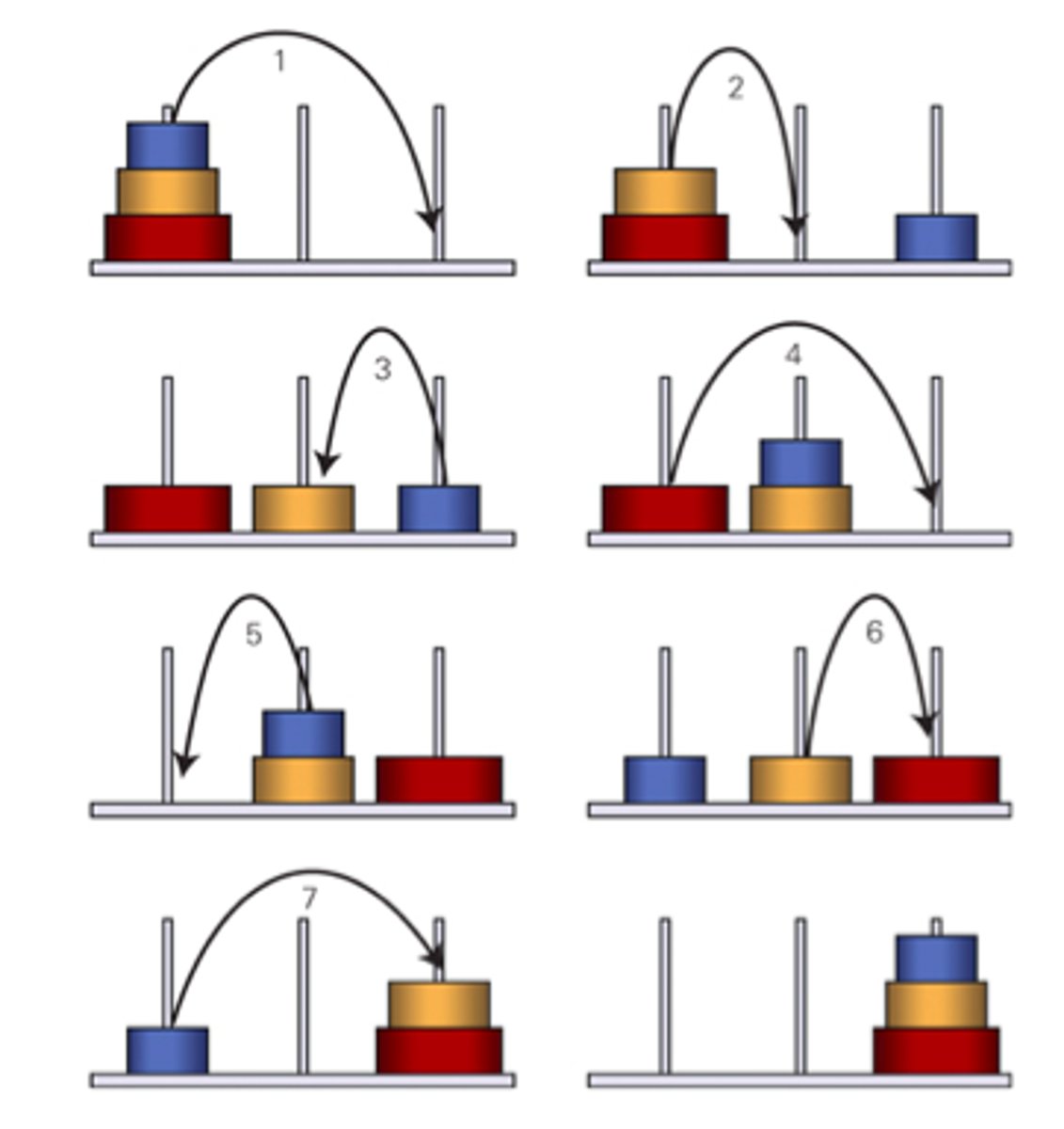
Arrangement Problems
require the problem solver to rearrange elements in a way that will satisfy a certain criterion
All problem elements presented
Must figure out how to arrange them
E.g., Anagrams (exutod → tuxedo); seating chart (for a wedding, how many tables, seating people appropriately); scheduling (have all the elements just need to figure out where to place meetings)
Don't need to figure out steps
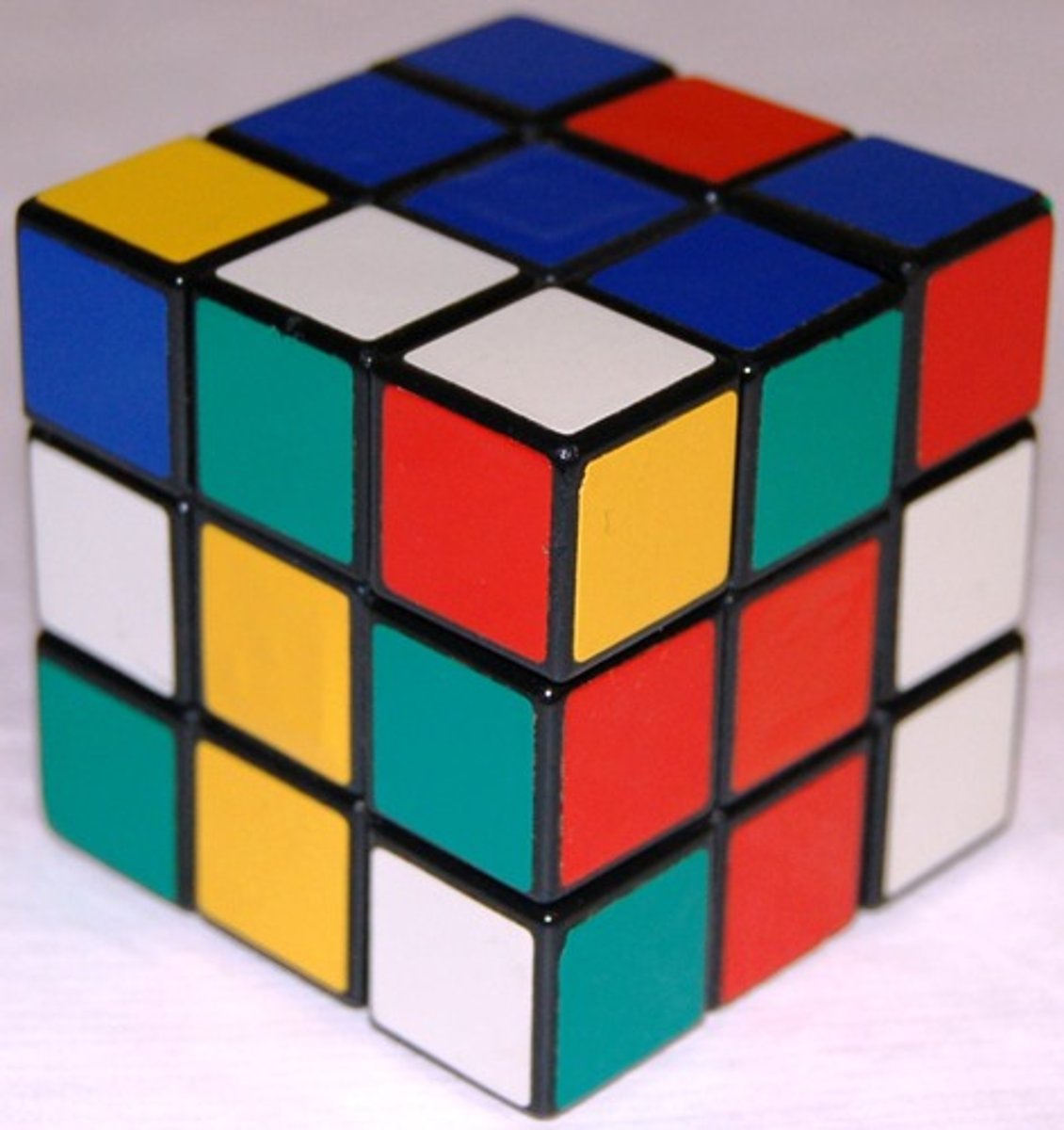
Induction Problems
present a series of examples and the solver must find the pattern
E.g., 1 2 3 5 8 13 ...
(adding the previous number to the following number)
Deduction Problems
premises or conditions are given and the solver must determine whether the conclusion fits
All Xs are Ys.
Z is not a Y
Therefore, Z is not an X. (Is that a correct conclusion?)
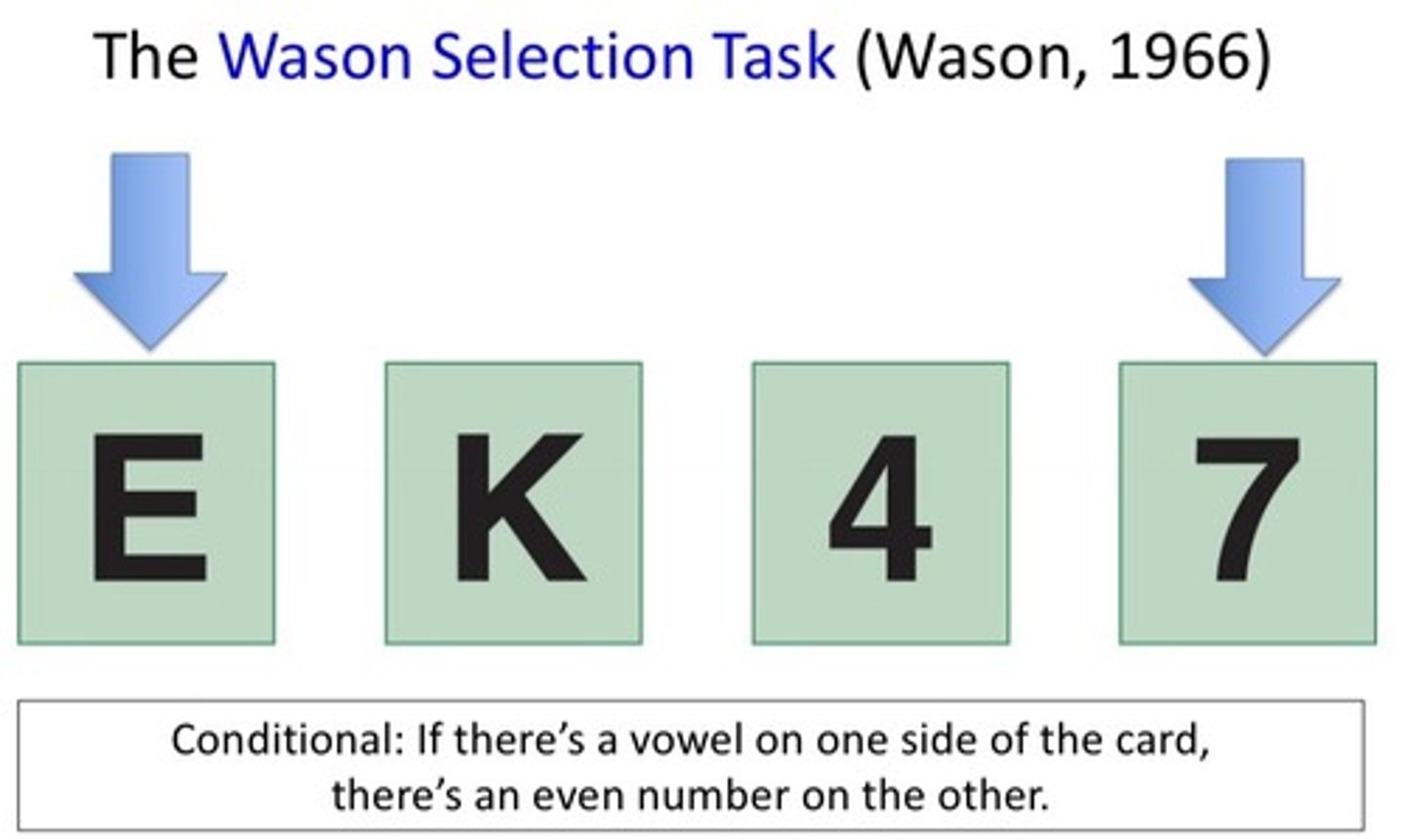
Divergent Problems
require the solver to generate as many solutions as possible to a given problem
Examples:
describe possible uses for a shovel (ex: shoveling dirt, digging a hole)
brainstorm many possible career paths
Creativity
the ability to produce novel and valuable ideas
Convergent Thinking
narrowing the available problem solutions to determine the single best solution
(thinking inside the box)
Divergent Thinking
expands the number of possible problem solutions (creative thinking that diverges in different directions)
(thinking outside the box)
Behaviorist Approach
Problem solving is associative learning
Stimuli will elicit responses
Response is either reinforced or not
Reinforced responses are strengthened
Non-reinforced responses are extinguished
Initial state is aversive
Motivates organism to respond
Puzzle box (Thorndike)
Series of trial-and-error responses in problem solving
Responses that work are strengthened
Responses that fail are weakened
Achievement of goal state is reinforcing
Responses become less random
Ex: cats escaping from boxes, behavior changes due to consequences
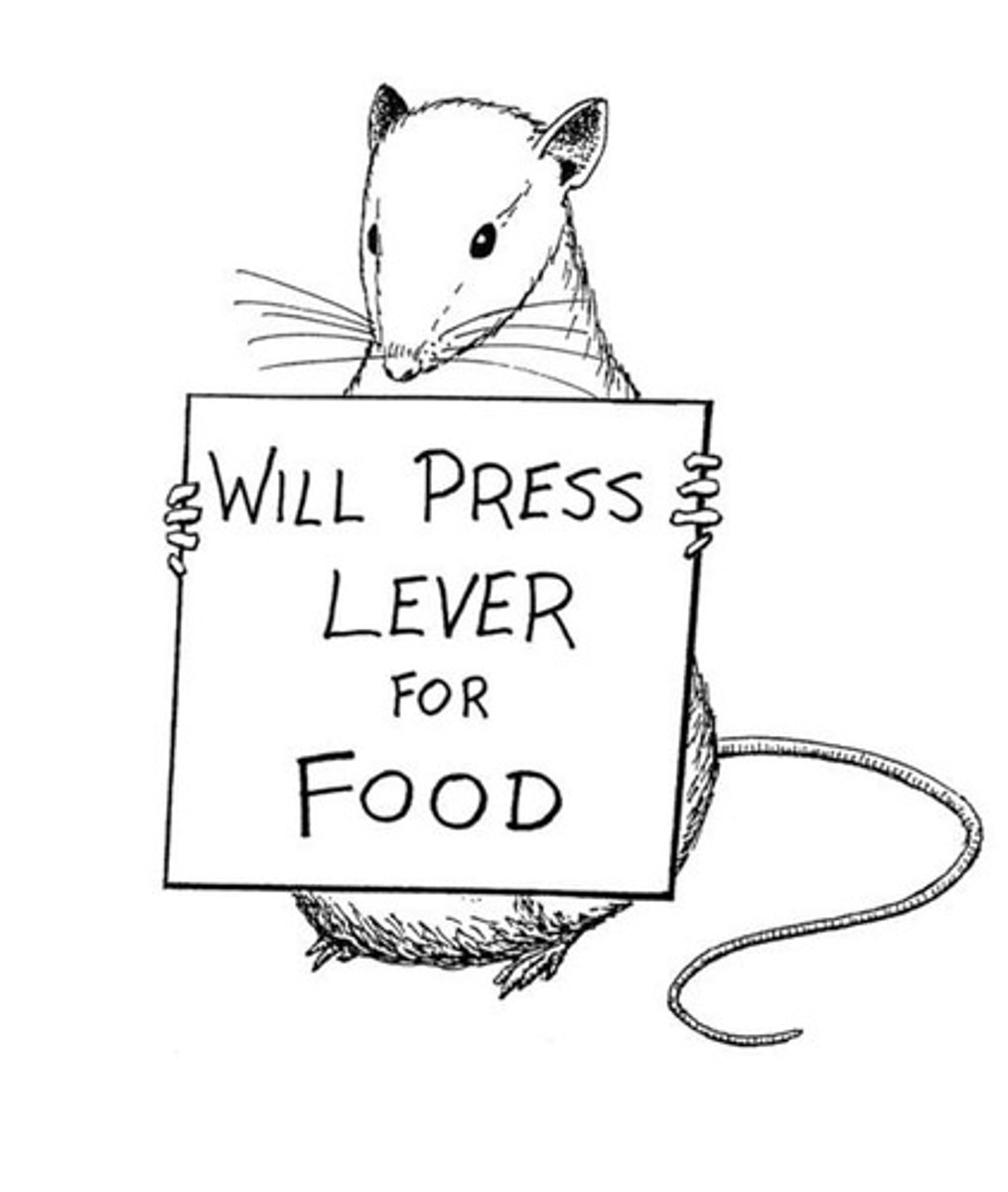
Gestalt Approach
Focus on higher order processing
Mentally restructure (reorganize) the problem elements
Insight: sudden realization of the solution
Kohler's suspended banana study
Problem solving is insightful and deliberate
Arrangement, organization
Reorganizing problem solving
Information Processing Approach
a perspective on understanding cognition that divides thinking into specific steps and component processes, much like a computer
Computers as inspiration
Represent the initial state and the goal state
Subgoal analysis (break the problem down into smaller, more manageable problems/steps/pieces)
Problem space (the representation of the initial state, goal state, subgoals)
Problem solving (traveling through problem space in a series of steps)
A = initial state (keys locked in car)
E = goal state (keys back in possession)
A → B (call roommate who has spare key)
B → C (get roommate to car)
C → D (get spare keys)
D → E (open door)

How important is it for a person to form an accurate representation of the problem at hand?
Correct solution dependent on representation
Failure in representation = no solution
Mental Set: what is it? When might it be good? When might it be bad?
a tendency to approach a problem in one particular way, often a way that has been successful in the past
Functional Fixedness
the tendency to think of things only in terms of their usual functions; an impediment to problem solving
Ex: Duncker's candle problem
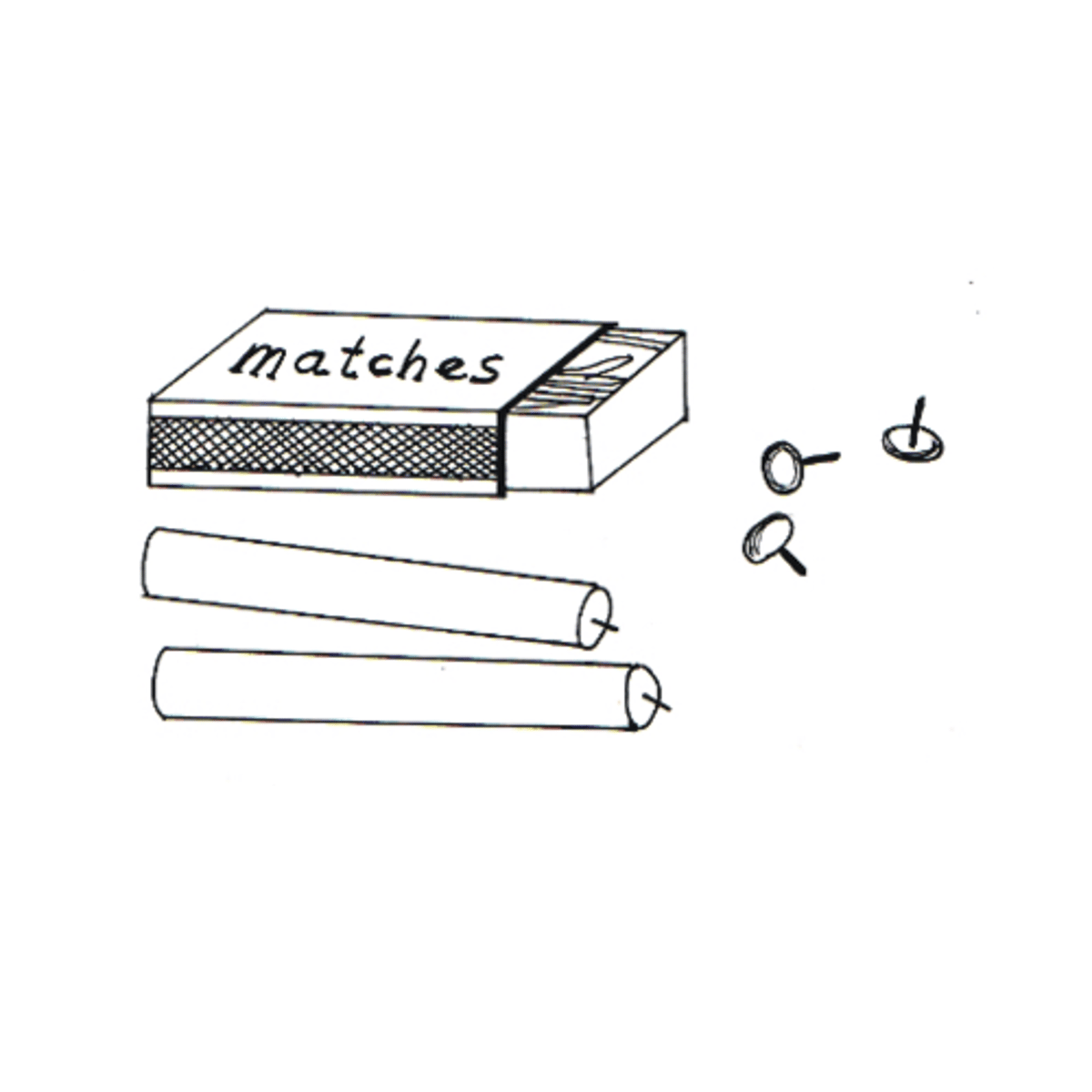
Describe how a person might use a heuristic to solve a problem. Pros and cons?
General strategies, or "rules of thumb," that can be applied to some types of problems
Advantage: Efficiency
Disadvantage: Does not guarantee correct solution
Give an example of a problem-solving heuristic.
Means-ends analysis
Breaking problem into subgoals (thinking about the different steps to get there)
A variation of means-end analysis:
Working backwards
Figure out the last step needed, then the next-to-the-last step, etc.
Using analogies
Solving one problem based on solution to similar problems
Insight
a sudden and often novel realization of the solution to a problem
Mistaken assumption blocking solution
e.g., issue with problem representation, mental set, functional fixedness
"Aha!" moment when mistaken assumption is removed/fixed
What's the difference between insight problems and non-insight problems? Which type gives the feeling of gradual progress toward a solution? Which type gives the feeling of little progress until the "Aha!" moment is reached?
Non-insight problems:
Like algebra: solve 16y2 - 40y + 25 = 121
or routine story problems
Gradual progress
Insight problems (nonroutine):
A prisoner was attempting to escape from a tower. He found in his cell a rope which was half long enough to permit him to reach the ground safely. He escaped. How could he have done this?
Incubation
productive inactivity
Why does taking a break from a problem sometimes lead to a solution?
Clears your mind of interfering info
Contextual changes can help you get away from conditions/cues that produce failure, finding new conditions/cues that help
Expertise
Exceptional knowledge and/or performance in some specific problem domain
Is it primarily a result of natural talent or extensive experience? Does expertise in one domain imply expertise in other domains?
Exceptional knowledge and/or performance in some specific problem domain
Achieved through repeated practice and experience over time to acquire an extensive body of knowledge and well-learned set of skills
Expertise in one domain does not guarantee expertise in other domains